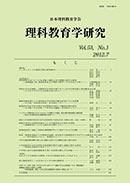Volume 49, Issue 1
Displaying 1-17 of 17 articles from this issue
- |<
- <
- 1
- >
- >|
Original Papers
-
2008 Volume 49 Issue 1 Pages 1-8
Published: July 25, 2008
Released on J-STAGE: June 30, 2022
Download PDF (1038K) -
2008 Volume 49 Issue 1 Pages 9-21
Published: July 25, 2008
Released on J-STAGE: June 30, 2022
Download PDF (1695K) -
2008 Volume 49 Issue 1 Pages 23-33
Published: July 25, 2008
Released on J-STAGE: June 30, 2022
Download PDF (1331K) -
2008 Volume 49 Issue 1 Pages 35-51
Published: July 25, 2008
Released on J-STAGE: June 30, 2022
Download PDF (1962K) -
2008 Volume 49 Issue 1 Pages 53-63
Published: July 25, 2008
Released on J-STAGE: June 30, 2022
Download PDF (1397K) -
2008 Volume 49 Issue 1 Pages 65-72
Published: July 25, 2008
Released on J-STAGE: June 30, 2022
Download PDF (960K) -
2008 Volume 49 Issue 1 Pages 73-88
Published: July 25, 2008
Released on J-STAGE: June 30, 2022
Download PDF (2271K) -
2008 Volume 49 Issue 1 Pages 89-95
Published: July 25, 2008
Released on J-STAGE: June 30, 2022
Download PDF (859K) -
2008 Volume 49 Issue 1 Pages 97-103
Published: July 25, 2008
Released on J-STAGE: June 30, 2022
Download PDF (922K) -
2008 Volume 49 Issue 1 Pages 105-112
Published: July 25, 2008
Released on J-STAGE: June 30, 2022
Download PDF (1141K) -
2008 Volume 49 Issue 1 Pages 113-121
Published: July 25, 2008
Released on J-STAGE: June 30, 2022
Download PDF (812K) -
2008 Volume 49 Issue 1 Pages 123-135
Published: July 25, 2008
Released on J-STAGE: June 30, 2022
Download PDF (1551K)
Note
-
2008 Volume 49 Issue 1 Pages 137-142
Published: July 25, 2008
Released on J-STAGE: June 30, 2022
Download PDF (771K) -
2008 Volume 49 Issue 1 Pages 143-150
Published: July 25, 2008
Released on J-STAGE: June 30, 2022
Download PDF (771K) -
2008 Volume 49 Issue 1 Pages 151-159
Published: July 25, 2008
Released on J-STAGE: June 30, 2022
Download PDF (1547K) -
2008 Volume 49 Issue 1 Pages 161-168
Published: July 25, 2008
Released on J-STAGE: June 30, 2022
Download PDF (2750K) -
2008 Volume 49 Issue 1 Pages 169-178
Published: July 25, 2008
Released on J-STAGE: June 30, 2022
Download PDF (1026K)
- |<
- <
- 1
- >
- >|
